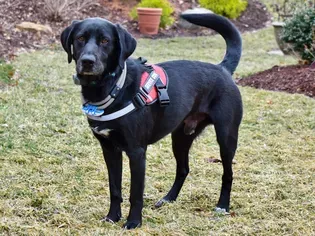How to Adopt a Failed Service Dog
Updated on 04/26/24

Embracing Second Chances: A Guide to Adopting a Failed Service Dog
As a testament to the unwavering bond between humans and animals, service dogs are meticulously trained to provide life-changing assistance to individuals with physical, cognitive, or emotional disabilities. However, despite their exceptional training, some service dogs may encounter unforeseen challenges that prevent them from fulfilling their assigned roles. These dogs, often referred to as "failed service dogs," are not failures; rather, they possess unique strengths and qualities that make them worthy of loving homes.
If you have ever considered adopting a pet, embracing a failed service dog can be a profoundly rewarding experience. Not only will you provide a deserving companion with a second chance, but you will also gain a loyal and affectionate friend who will enrich your life in countless ways.
To provide you with a comprehensive guide to adopting a failed service dog, we will delve into the following topics:
Understanding Why Service Dogs Fail
Failed service dogs do not represent a failure on the part of the dog or its trainer. Instead, they are simply dogs who have encountered obstacles that have prevented them from meeting the specific requirements of service work. These obstacles can range from physical limitations to behavioral issues that are incompatible with service dog responsibilities.
Examples of Reasons for Failure:
* Medical conditions: Dogs may develop physical conditions that impact their ability to perform service work, such as mobility impairments or chronic illnesses.
* Behavioral challenges: Some dogs may exhibit behaviors that are incompatible with service work, such as reactivity, anxiety, or aggression.
* Unmet training goals: Despite extensive training, some dogs may struggle to meet the specific training requirements for service work.
* Personality mismatch: The temperament or personality of a dog may not be well-suited for the demanding responsibilities of service work.
Recognizing the Benefits of Adopting a Failed Service Dog
While failed service dogs may not be fully capable of performing their intended roles, they possess a wealth of positive qualities that make them exceptional companions.
* Trained and socialized: Service dogs receive extensive training and socialization, making them highly obedient, well-behaved, and comfortable in various environments.
* Loyal and affectionate: Service dogs are deeply bonded with their handlers, and this bond often extends to their new owners, making them devoted and affectionate companions.
* Unique skills: Even if they are unable to perform specific service tasks, failed service dogs may have unique skills that can be beneficial in other ways, such as retrieving items, providing emotional support, or simply being a loving presence.
The Adoption Process for Failed Service Dogs
Adopting a failed service dog typically involves working with organizations or individuals specializing in placing these dogs in loving homes.
* Research organizations: Numerous organizations are dedicated to finding homes for failed service dogs. Contact these organizations to inquire about available dogs and their adoption process.
* Attend adoption events: Adoption events are often held to introduce failed service dogs to potential adopters. These events provide an opportunity to meet the dogs and learn more about their backgrounds.
* Interview with organizations: Organizations may conduct interviews with potential adopters to assess their suitability for adopting a failed service dog. This often involves discussing your lifestyle, experience with dogs, and ability to provide a stable and loving home.
Preparing Your Home and Family for a Failed Service Dog
Welcoming a failed service dog into your home requires thoughtful preparation to ensure their comfort and wellbeing.
* Create a safe and comfortable space: Provide a designated area for the dog to rest, play, and feel secure. Consider their physical limitations and provide appropriate accommodations.
* Establish clear boundaries and rules: Set clear expectations for the dog's behavior in your home and establish consistent rules for their interactions with family members.
* Provide ongoing training: While failed service dogs have received extensive training, they may still benefit from additional reinforcement and guidance in your home environment.
Conclusion
Adopting a failed service dog is a transformative experience that offers both the dog and the adopter a second chance at happiness. These dogs have so much love and potential to give, and they deserve to find homes where they can thrive as cherished companions. By embracing these exceptional animals, you not only provide them with a loving home but also enrich your own life with their unwavering loyalty and companionship.
Explore More Pets

Basic Training
Puppy and Baby Introductions

Working Dog Breeds
All About Search and Rescue Dogs

Dog Treatments
Puppy Vaginitis: Signs, Causes and Treatment

Dog Adoption
After More Than 1,200 Days in the Shelter, Coco Goes Home

Basic Training
How to Train Your Puppy to Go on Potty Pads

Hybrid Dog Breeds
The Difference Between a Mutt, Mixed Breed, or Designer Dog?

Dog Treatments
Nail Problems in Dogs

Puppies
7 Reasons Why Two Dogs Are Better Than One